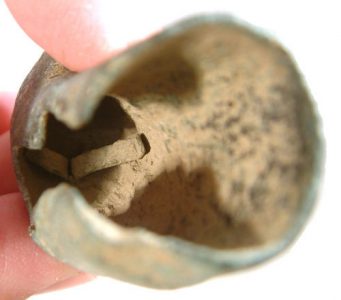CART FITTING 445512
Description: An incomplete cast copper-alloy Roman terminal in the form of an eagle's head emerging from a tubular sleeve. The object is hollow except for the solid beak. It measures 49.51mm in length, 22.16mm in max.width and 47.22mm in depth from the beak to the back of the sleeve. The object weighs 66.22g. It is missing part of one side of the head and sleeve (old damage).
Projecting inside the head from the outside at the top are two lengths of sheet metal bending in opposite directions, presumably fixing strips. They are c.3mm wide and the longest is perhaps 14mm, although it is not possible to measure them inside the socketed head.
The head is now very worn and has lost all of its original patina. However traces of feathers delineated both by moulding and incisions and still apparent, especially on the intact side of the head. There also appears to be a mane of feathers at the back of the head. The eyes are moulded and the top of the head is flat, with a brow ridge above each eye. To either side of the hooked beak where it emerges from the top of the head is a small hole, presumably damage as the metal is thin at this point. The eagle grasps a spherical object within its open beak.
The head emerges from a sleeve consisting of three petals (one of these is mostly missing, in the damaged area). The central petal is narrower than the others, but a little taller. The petals themselves emerge from a double collar, above a main section of hexagonal (probably - the damage makes this unclear) cross-section. To the inside surface this is circular in cross-section and 18.69mm in diameter, with traces of blackening on the inside surface. The sleeve extends c.12.5mm below the double collar to its open end. The metal is now greeny-blue in colour with some pitting.
Perhaps the closest parallel found for this artefact is a well rendered terminal with iron/lead core from Berkshire - HAMP-E88954. This in turn references a similar example from Chichester illustrated in Down 1978 (296, 297; ref. 47). As its description states, such objects tend to be identified as Roman cart fittings to which the reins were tied when the vehicle was stationary. Examples for which the body element is complete suggest that the socket would have had a hooked projection, probably in the form of a swan's head (ex. Crummy 1983, 106; ref. 2545; Webster 1958, 71; fig. 3, ref. 37). The similarity of the Colchester example with this one suggest that the damage to the side of the object may well have been from losing its hooked projection.
These cart fittings seem to have a relatively standardised design, characterised by the sphere within the eagle's beak; variable would seem to be the number of petals and the form of the socket - circular (ex. Webster 1958, 95, 97; fig. 8, ref. 232), hexagonal (ex. Crummy 1983, 106; ref. 2545), heptagonal (HAMP-E88954), octagonal (Down 1978, 296, 297; ref. 47). The distribution and date of similar pieces suggests a military connection and a 1st-century date (Webster 1958, 75, where full references are given), although as more examples come to light such a generalisation may come to be refined. Indeed, with this example and others - HAMP-E88954, SF-97C2C8, WMID4346, SUSS-18A703, SF-9CC792 - the Portable Antiquities Scheme has started to make a contribution to the distribution pattern.
Date: 43 - 100
Object type: CART FITTING
Last import: August 15, 2017


